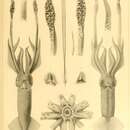Comprehensive Description
provided by Smithsonian Contributions to Zoology
Todaropsis eblanae (Ball, 1841)
The golden arrow squid, T. eblanae, was first reported from the southwest Pacific by Lu (1982). Additional adult specimens of T. eblanae examined by Dunning (1988c) were caught in demersal trawls in eastern Australian waters from 17°44′S to 34°53′S where bottom depths varied from 200 m to 678 m and bottom temperatures (where recorded) varied from 11.4° C to 17.5° C. Specimens described by Lu (1982) were trawled in depths to 805 m and as far south as 37°12′S off the eastern Australian coast. Figure 3 shows locations where T. eblanae has been reported from the southwest Pacific.
The available material does not allow a detailed assessment of this species’ distribution with bottom depth, but extensive trawl studies on the continental shelf off the eastern Australian coast suggest that it is restricted to continental slope waters in this region. Adults were not represented in pelagic trawl catches, indicating that T. eblanae is predominantly a demersal rather than a midwater species in this region (Dunning, 1988c).
The larvae of T. eblanae have not been described in the literature, and no larvae that could be assigned to this species have been reported from the southwest Pacific. Three juveniles of 21 mm mantle length (ML), 22 mm ML, and 33 mm ML were trawled in midwater off central New South Wales (34°S–35°S) in January 1979 and March 1981 (bottom depths of 70–170 m, temperatures at capture depth 16.2°–19.7° C) (Dunning, 1988c).
Martialia hyadesi (Rochebrune and Mabille, 1889)
Since the mid-1980s, Martialia hyadesi has become a significant component in the southwest Atlantic Ocean jig fishery off Argentina and the Falkland Islands (Rodhouse and Yeatman, 1990). South Pacific reports of M. hyadesi have been from the Eltanin Fracture Zone east of 160°W (Nesis, 1987), from adults stranded on the beach at Macquarie Island (54°30′S, 158°57′E) after a storm (O'Sullivan et al., 1983), and from off the Campbell Islands (∼52°30′S, 170°E) (M.J. Imber, pers. comm. cited in Rodhouse and Yeatman, 1990).
Uozumi et al. (1990) provided the first record of this species from southern New Zealand waters. Juveniles (9–101 mm ML), but no adults, were caught using a fine mesh midwater trawl in and south of the Subtropical Convergence Zone (south of 45°S) during midwinter 1985 at the edge of the continental shelf and in deeper water.
- bibliographic citation
- Voss, N. A. and Sweeney, M. J. 1998. "Systematics and Biogeography of cephalopods. Volume II." Smithsonian Contributions to Zoology. 277-599. https://doi.org/10.5479/si.00810282.586.277
Comprehensive Description
provided by Smithsonian Contributions to Zoology
Todaropsis eblanae (Ball, 1841)
DIAGNOSIS.—As for genus.
ORIGINAL REFERENCE.—Ball, 1841:364.
TYPE LOCALITY.—Dublin Bay, Ireland.
DEPOSITION OF TYPES.—Unknown (Science and Art Museum, Dublin at the turn of the century, fide Hoyle (1903)).
Paratypes: One designated.
DISTRIBUTION AND BIOLOGY.—Todaropsis eblanae is a demersal species of the deeper shelf and continental slope occurring throughout the Mediterranean Sea and in the eastern Atlantic from the Shetland Islands and Skagen, Denmark, in the north, to Capetown, South Africa, in the south (Adam, 1952); in the Indian Ocean on the Agulhas Bank, Mascarenes Ridge, and western Australian coast; and off the eastern Australian coast to as far as 37° 12′S(Korzun et al., 1979; Lu, 1982; Nesis, 1987; Dunning, 1988b).
Todaropsis eblanae is usually associated with sandy or muddy bottoms, although small juveniles have been taken in near-surface waters using midwater trawls (Dunning, 1988b). In the Atlantic and in the Mediterranean Sea, this species has been trawled in depths of 20–700 m but appears confined to depths of less than 200 m in the North Sea (Clarke, 1966).
Todaropsis eblanae was caught in Australian waters in demersal trawls where depths varied from 200 m to 805 m and bottom temperatures varied from 9.0°C to 17.5°C. The distributions of Todaropsis eblanae and Nototodarus hawaiiensis overlap significantly off both the east and northwest coasts of Australia. These species were caught in demersal trawls together with Todarodes pacificus pusillus (Dunning, 1988a) in depths of 200–250 m off the northeast Australian coast.
Male and female T. eblanae were relatively evenly represented (28:34) in material examined from northeastern Australian waters (Dunning, 1988b), in contrast to the female- dominated sex ratios observed in more oceanic ommastrephids (especially Ommastrephes bartramii and Sthenoteuthis oualaniensis).
Female T. eblanae from Australian waters reach maturity at approximately 150 mm ML; males mature from 120 mm ML. Spawning apparently occurs in east coast waters at least from late summer to early winter (Lu, 1982; Dunning, 1988b). Catalonian (Mediterranean) Sea populations of T. eblanae were studied by Mangold-Wirz (1963). Males reached maturity at 110–140 mm ML and produced about 200 spermatophores; females matured at 160–190 mm ML and carried 5000 to 10,000 eggs. The spawning season for this population was found to be protracted in this region, lasting at least nine months, from March to November (spring to late autumn).
Prey items are unknown, but predators are known to include Heptanchus (Adam, 1952) and Germo alalunga (Bouxin and Legendre, 1936).
- bibliographic citation
- Voss, N. A. and Sweeney, M. J. 1998. "Systematics and Biogeography of cephalopods. Volume II." Smithsonian Contributions to Zoology. 277-599. https://doi.org/10.5479/si.00810282.586.277
Todaropsis eblanae: Brief Summary
provided by wikipedia EN
Todaropsis eblanae, also known as the lesser flying squid, is a species of short finned squid in the monotypic genus Todaropsis of the family Ommastrephidae.
- license
- cc-by-sa-3.0
- copyright
- Wikipedia authors and editors
Habitat
provided by World Register of Marine Species
demersal, shelf to slope
van der Land, J. (ed). (2008). UNESCO-IOC Register of Marine Organisms (URMO).
- license
- cc-by-4.0
- copyright
- WoRMS Editorial Board

